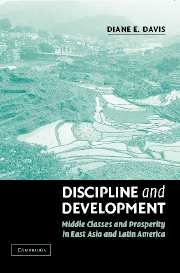Book contents
- Frontmatter
- Contents
- Preface
- DISCIPLINE AND DEVELOPMENT
- 1 An Introduction to Middle Classes, Discipline, and Development
- 2 Middle Classes and Development Theory
- 3 Discipline and Reward: Rural Middle Classes and the South Korean Development Miracle
- 4 Disciplinary Development as Rural Middle-Class Formation: Proletarianized Peasants and Farmer-Workers in Argentina and Taiwan
- 5 From Victors to Victims? Rural Middle Classes, Revolutionary Legacies, and the Unfulfilled Promise of Disciplinary Development in Mexico
- 6 Disciplinary Development in a New Millennium: The Global Context of Past Gains and Future Prospects
- Appendix A Cases, Comparisons, and a Note on Methodology and Sources
- Appendix B Defining the Middle Class: Notes on Boundaries and Epistemology
- Appendix C Tables
- Bibliography
- Index
Appendix A - Cases, Comparisons, and a Note on Methodology and Sources
Published online by Cambridge University Press: 31 July 2009
- Frontmatter
- Contents
- Preface
- DISCIPLINE AND DEVELOPMENT
- 1 An Introduction to Middle Classes, Discipline, and Development
- 2 Middle Classes and Development Theory
- 3 Discipline and Reward: Rural Middle Classes and the South Korean Development Miracle
- 4 Disciplinary Development as Rural Middle-Class Formation: Proletarianized Peasants and Farmer-Workers in Argentina and Taiwan
- 5 From Victors to Victims? Rural Middle Classes, Revolutionary Legacies, and the Unfulfilled Promise of Disciplinary Development in Mexico
- 6 Disciplinary Development in a New Millennium: The Global Context of Past Gains and Future Prospects
- Appendix A Cases, Comparisons, and a Note on Methodology and Sources
- Appendix B Defining the Middle Class: Notes on Boundaries and Epistemology
- Appendix C Tables
- Bibliography
- Index
Summary
This book employs a comparative-historical methodology and does so for the standard reasons: to build and test hypotheses. By explicitly comparing Taiwan and South Korea with Argentina and Mexico, differences between East Asia and Latin America are considered. Yet with these four cases, there also is material to theorize developmental differences within the same regional contexts (i.e., between Mexico and Argentina, on one hand, and between South Korea and Taiwan on the other). After all, although both South Korea and Taiwan are considered great successes, the latter has not suffered the debt and banking crises that have plagued the former. In Latin America, similarly, there are significant differences: Mexico is uniformly considered to have forged a more stable macroeconomic path than Argentina, despite the recent gains (and setbacks) experienced by both. Argentina's current economic situation proves this view.
The selection of these particular four countries owes partly to the desire to hold constant the factors generally used to account for development trajectories. In all four cases equally interventionist, strong, and bureaucratized states with considerable power and institutional capacity guided national development during the initial periods of rapid and sustained industrialization. In each country the state held considerable political power to act with unrivaled authority, leading most scholars to conclude that these were “strong” states with considerable autonomous capacity. Moreover, each of their governments repressed or restricted democratic participation and civil liberties during critical junctures of industrial development, such that all four possessed semi-authoritarian political systems routinely identified as buttressing the state's institutional capacity to call the shots (military government in South Korea and Argentina, corporatist one-party rule in Taiwan and Mexico).
Information
- Type
- Chapter
- Information
- Discipline and DevelopmentMiddle Classes and Prosperity in East Asia and Latin America, pp. 359 - 362Publisher: Cambridge University PressPrint publication year: 2004
